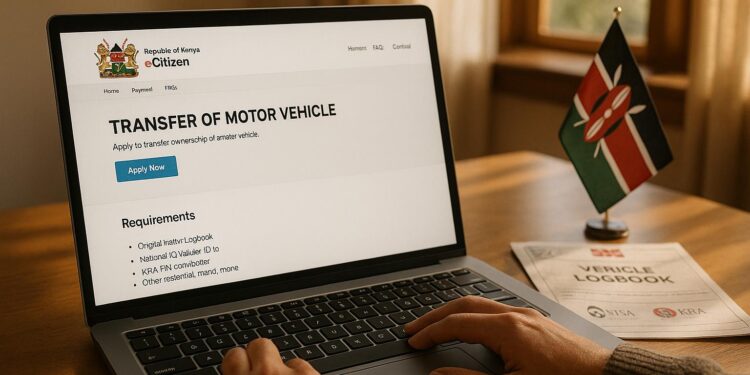In Kenya, transferring a car logbook is mandatory after a vehicle sale. The logbook, issued by NTSA, serves as legal proof of ownership. Failing to transfer ownership within 14 days can lead to legal penalties and complications, especially with insurance claims or liabilities. The NTSA TIMS portal simplifies the process, but you’ll need specific documents to complete the transfer.
Key requirements:
- For individuals: Original logbook, Kenyan ID (or passport for foreigners), KRA PINs (buyer and seller), and Form C.
- For companies: Certificate of incorporation, KRA PINs, letter of authority (if applicable), and Form C.
- Optional but useful: Sale agreement and vehicle inspection report (if required).
Steps on NTSA TIMS portal:
- Seller initiates the transfer online by entering buyer details.
- Buyer accepts the transfer, uploads required documents, and pays the transfer fee.
- Track progress via the portal, with approval typically taking 3–5 business days.
Avoid delays by ensuring all documents are clear, accurate, and uploaded as colored PDFs. After approval, the new logbook is dispatched within 7–10 business days. For any issues, contact NTSA with your reference number.
Pro tip: Start the process early to avoid penalties or delays. Double-check all details before submission for a smooth experience.
How To Do Vehicle Ownership Transfer Through eCitizen
Documents You Need for Car Logbook Transfer
Having the right documents in order is crucial when transferring a car logbook. Even a small mistake or missing document can cause delays or outright rejection. The NTSA has specific requirements depending on whether the transfer involves an individual or a company. Below is a detailed guide to help you navigate the process.
Documents for Individual Buyers
If you’re buying a car as an individual, there are several essential documents you’ll need to complete the transfer. First and foremost, the original vehicle logbook is a must-have. Double-check that the logbook is authentic and that its details match the vehicle exactly.
For identification, Kenyan citizens must present a valid Kenyan ID, while foreigners are required to provide a valid passport or alien ID. Additionally, both the buyer and seller need to submit their KRA PIN certificates to confirm tax compliance.
Another key document is Form C (Transfer Application Form), which must be filled out accurately by both parties. This form serves as the official application for the transfer and captures all the necessary details.
In some cases, a vehicle inspection report may be required. If so, ensure the report is valid within the 30-day window.
While not mandatory, a sale agreement is highly recommended. This document outlines the terms of the sale, such as the agreed price, vehicle condition, and any warranties, offering protection for both the buyer and seller.
Extra Documents for Company Transfers
When it comes to company transfers, additional paperwork is needed. Companies must provide a certificate of incorporation, which verifies the legal existence of the business. This replaces the personal identification required for individual transfers.
If someone other than the company’s registered directors is handling the transfer, a letter of authority is mandatory. This document specifies who is authorized to act on behalf of the company during the process.
The company also needs to submit its KRA PIN certificate, along with the KRA PIN certificate of the authorized signatory. This ensures both the company and the individual managing the transfer are compliant with tax regulations.
As with individual transfers, companies must complete Form C and submit the original vehicle logbook. If a vehicle inspection report is required, it must also fall within the same 30-day validity period.
Document Checklist Table
| Document | Individual Transfer | Company Transfer | Notes |
|---|---|---|---|
| Original Vehicle Logbook | ✅ Required | ✅ Required | Must be authentic and match vehicle details |
| Valid Kenyan ID | ✅ Required | ❌ Not applicable | For Kenyan citizens only |
| Valid Passport/Alien ID | ✅ Required | ❌ Not applicable | For foreign nationals |
| KRA PIN Certificate | ✅ Required | ✅ Required | For both buyer and seller |
| Form C (Transfer Application) | ✅ Required | ✅ Required | Must be completed by both parties |
| Vehicle Inspection Report | ✅ If applicable | ✅ If applicable | Valid for 30 days only |
| Sale Agreement | Recommended | Recommended | Provides additional security |
| Certificate of Incorporation | ❌ Not applicable | ✅ Required | Confirms the company’s legal existence |
| Letter of Authority | ❌ Not applicable | ✅ Required | Needed if an authorized person handles the transfer |
Before submitting your application, ensure all documents are clear, colored PDF scans if you’re applying online. Poor-quality scans are a common reason for delays or rejections. Always keep the original documents as a backup and certify photocopies when required.
How to Change Ownership on NTSA TIMS Portal

Changing vehicle ownership using the NTSA TIMS portal is straightforward when you have all the required documents. This online platform streamlines the process for both sellers and buyers. Here’s how it works:
Starting the Transfer as the Seller
First, the seller needs to log in to the NTSA TIMS portal. Once logged in, select the vehicle you want to transfer and input the buyer’s details as prompted. Carefully review all the information before submitting the transfer request. After submission, you’ll receive a reference number – keep it handy for tracking the progress.
Accepting the Transfer as the Buyer
For buyers, log in to the NTSA TIMS portal and check for any pending transfer requests. Review the details provided by the seller to ensure everything matches. If the information is accurate, follow the instructions to upload the necessary documents and complete your part of the process.
Transfer Fees and Processing Time
To finalize the transfer, a payment is required. The NTSA TIMS portal supports payments through M-Pesa, bank cards, or direct bank transfers. Follow the portal’s steps to make the payment and ensure you receive a confirmation and receipt.
Once the payment is confirmed, use the reference number to track your application. After approval, the new logbook will be sent to the address you provided during the process.
sbb-itb-e5ed0ed
Mistakes to Avoid During Transfer
Transferring vehicle ownership through the NTSA TIMS portal can hit unnecessary roadblocks if common mistakes are made. By being aware of these errors, you can help ensure your application gets processed quickly and without hiccups.
Common Transfer Errors
Always upload the original logbook as a high-resolution color PDF. Low-quality scans or photocopies can lead to rejections since the NTSA requires clear and legible scans of the original document to verify all vehicle details.
Stick to the required documents – don’t include irrelevant files like payment receipts or blank pages. Adding unnecessary files can confuse the process and may result in NTSA staff requesting a resubmission.
Double-check buyer information to avoid errors. Incorrect details, such as a misspelled name or wrong ID number, can cause the application to be rejected, forcing you to start over.
Ensure the buyer accepts the transfer request promptly. Delays often happen when buyers fail to check their NTSA TIMS portal account or provide incorrect contact details, leading to missed notifications.
By steering clear of these errors, you can save time and avoid frustration.
Tips for Smooth Processing
Thoroughly review all documents and buyer details before submission. Make sure every document is clear and legible, and cross-check the buyer’s national ID number, phone number, and email address to ensure accuracy.
"Transfer of ownership services are accessible through the eCitizen platform and the process takes 3 working days. Motor vehicle owners are required to counter-check all documents and information provided before submitting applications." – NTSA
Paying close attention to these details can make the transfer process seamless and stress-free.
What Happens After You Submit
Once you’ve completed the transfer process online, it’s important to know what happens next. After submitting your logbook transfer application on NTSA TIMS, the processing period officially begins. Staying on top of your application’s progress is key, so let’s dive into how you can track its status and handle any potential setbacks.
How to Track Your Application
The NTSA service portal offers real-time updates on your application status. To check the progress, log into your TIMS account, head to the "Vehicle Registration" section, and select "Transfer History." Here, you’ll find all your submitted applications along with their current status.
The status updates will tell you where things stand. If everything checks out, you’ll see an "Approved" status. If there are issues, statuses like "Rejected", "Not Approved", or "Pending Correction" may appear. These updates happen in real time, so there’s no need to keep refreshing the page.
For added convenience, you can subscribe to SMS alerts during your TIMS portal registration. These notifications will keep you informed directly on your phone, though some users have noted occasional inconsistencies in delivery. To avoid missing updates, it’s a good idea to log in periodically. The buyer will also receive notifications through their eCitizen or TIMS account to review and respond to the transfer request.
Dealing with Delays or Rejections
Sometimes, things don’t go as smoothly as planned. If you encounter delays or rejections, here’s what to do. NTSA generally reviews logbook transfer applications within 3–5 business days after submission. If your application gets rejected, carefully review the listed issues, make the necessary corrections, and resubmit.
"Typically, the process takes three working days." – Peach Cars
A "Pending Correction" status means additional documents or fixes are required. Be sure to address these promptly. Starting the transfer process early is always a smart move, as NTSA systems can occasionally experience delays. This gives you extra time to handle any surprises.
Once your application is approved, the new logbook is typically dispatched within 7–10 business days. Depending on your location and postal service efficiency, your logbook may be ready for collection within seven working days from the approval date – not the submission date.
If delays stretch beyond these timeframes, reach out to NTSA customer service through their official channels. Having your application reference number on hand will make it easier for them to assist you quickly.
Key Points for Successful Logbook Transfer
To ensure a smooth logbook transfer, preparation is everything. Start by gathering all the required documents and double-checking their accuracy.
Both the buyer and seller must provide valid KRA PINs and a fully completed Form C. Remember, any vehicle inspection report is only valid for 30 days. If the transfer involves a company, you’ll also need the Certificate of Registration and the organization’s PIN. Before moving forward, verify the current logbook details through an online NTSA Car Search.
When scanning your documents, make sure they are in color PDF format and use clear, descriptive file names for easy identification. These steps align with the online transfer process described earlier. Carefully review all buyer and seller details to avoid unnecessary delays or rejections.
For forced transfers, additional documents are required. These include a sale agreement, police abstract, sworn affidavit, completed Form XI, as well as the buyer’s valid ID and KRA PIN.
FAQs
What happens if I don’t transfer my car logbook within 14 days in Kenya?
If you don’t transfer your car logbook within the 14-day window in Kenya, you might face legal penalties, including fines. On top of that, delaying the process can create headaches down the line, like making it harder to sell the car or prove you’re the rightful owner. Driving a car without completing the transfer is also against the law, which could lead to even more legal trouble.
To steer clear of these issues, make sure to complete the transfer process on time and submit all the required documents to the NTSA.
What should I do to ensure my document scans meet NTSA standards and avoid delays in the logbook transfer process?
To ensure there are no delays with your logbook transfer, make sure your document scans are clear, high-quality, and in color. Always submit them in PDF format, and double-check that the documents are complete and easy to read. Typically, you’ll need to provide the logbook, ID copies, and transfer forms.
Blurry or incomplete scans are a common reason for rejections. Take a moment to review your scans carefully – confirm that all details are visible and legible before uploading. A little extra effort up front can save you a lot of time later on.
What can I do if my car logbook transfer application is rejected or delayed by NTSA in Kenya?
If the NTSA rejects or delays your car logbook transfer application, the first step is figuring out why. They usually send feedback via SMS or notifications, pointing out issues like missing documents, unpaid fines, or mistakes in the application.
To fix this, carefully review your application to ensure all details are correct and all required documents are included. Address any unresolved issues, then resubmit your application. If the delay continues, you can contact NTSA through their official channels or visit their offices for help. Acting quickly can prevent further hold-ups in the process.
Related Blog Posts
- How to transfer car ownership in Kenya: updated 2025 guide
- Kenya vehicle transfer: step-by-step process & costs
- Transferring a car title in Nairobi: docs, fees & tips
- Car ownership transfer in Kenya: common pitfalls to avoid




